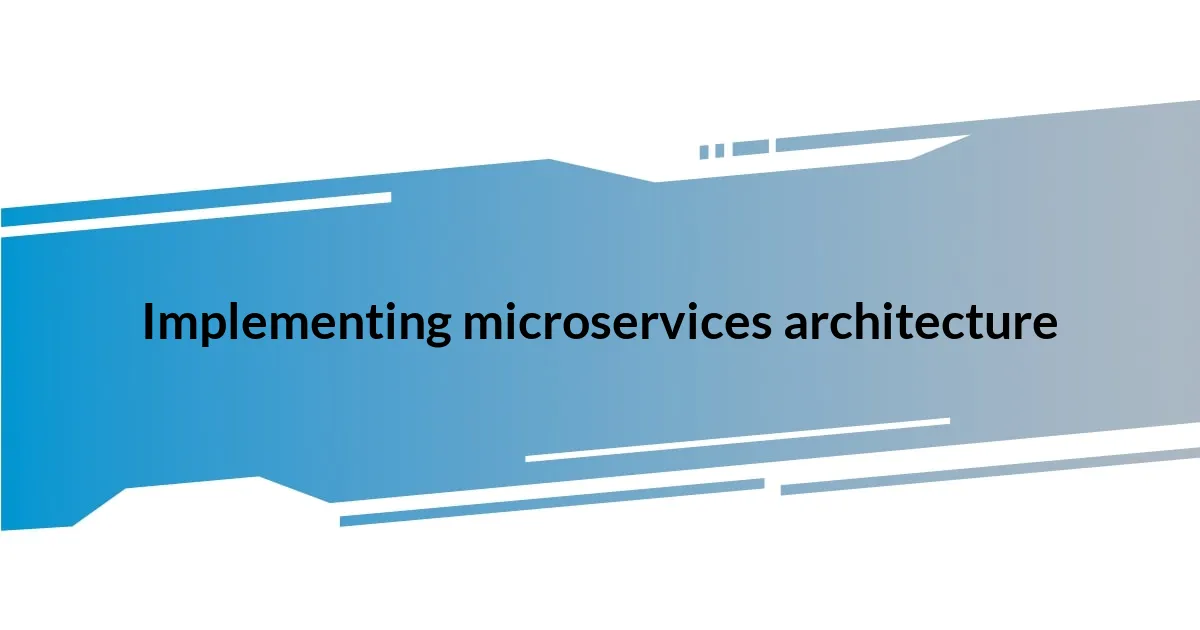Key takeaways:
- Understanding scalability requires careful forecasting of user load and anticipating traffic patterns to avoid system failures during unexpected surges.
- Choosing the right technology stack is crucial for long-term success; decisions should balance familiarity, performance, and community support to future-proof your backend.
- Implementing microservices architecture enhances flexibility and scalability but requires effective communication and observability for maintenance and debugging.
- Automating deployment processes through CI/CD pipelines enhances efficiency and team confidence, but it’s important to maintain a balance with manual oversight to ensure quality and user experience.

Understanding scalability requirements
Understanding scalability requirements begins with asking the right questions. What does your application need to handle today, and how fast do you expect that growth to occur? I remember when I first started building a backend for a startup; we underestimated our user load and quickly learned that careful forecasting is crucial.
When considering scalability, it’s essential to think not just about increasing capacity but also about how the system will perform under pressure. For instance, I once launched a feature that went viral overnight, and our servers crashed. It was a stark reminder that anticipating user behavior and traffic patterns is as important as having the right technology in place.
Finally, remember that scalability isn’t just a technical issue—it’s a holistic approach that involves your architecture, budget, and timeline. I like to reflect on the balance between these factors because I’ve experienced the tension firsthand. Relying solely on one aspect can lead to frustrations down the road, so it’s crucial to ensure every piece works seamlessly together. How do you currently prioritize these elements in your projects?

Choosing the right technology stack
Choosing the right technology stack can feel overwhelming, but it’s one of the most critical decisions I’ve made when building scalable backends. I vividly remember choosing between Node.js and Python for a new project. After discussions with the team and weighing the pros and cons, we opted for Node.js. Its non-blocking architecture aligned perfectly with our needs for speed and scalability. If I hadn’t listened to my instincts, we might have chosen a less suitable option.
When evaluating your options, consider not just current requirements but also long-term goals. I encountered this during a project where we initially chose a simpler database like SQLite. It served us well at first but soon became a bottleneck as our user base grew. Transitioning to a more robust option like PostgreSQL taught me the importance of future-proofing your tech choices. In hindsight, I wouldn’t have rushed the decision; a little more foresight would have saved us significant headaches later.
Ultimately, balance between familiarity, performance, and community support is vital. I’ve found that choosing widely adopted technologies allows for better support and resources. For example, when we shifted to using Docker for containerization, the community around it provided invaluable help, making our transition smoother. It’s these little choices that accumulate over time, shaping the resilience of your backend.
| Technology | Pros |
|---|---|
| Node.js | Highly scalable, non-blocking I/O, great for real-time applications |
| Python | Readable syntax, strong community, good for rapid development |
| PostgreSQL | Advanced features, strong data integrity, great for complex queries |
| SQLite | Lightweight, easy to set up, good for small projects |
| Docker | Consistent environments, easy to deploy, broad support from the community |

Designing for performance and reliability
When I’m designing for performance and reliability, I often recall a moment from my early days of backend development. One day, after deploying a significant update, the site faced an unexpected surge in traffic. My heart raced as I watched our response times slow and user complaints roll in. That experience taught me that reliable systems must be rigorously tested under expected load conditions before going live. It’s not just about building fast; it’s about building something that can keep up when the unexpected happens.
Here are some key aspects to consider for optimal performance and reliability:
- Load Testing: Simulate high traffic scenarios to identify bottlenecks and ensure your backend can handle spikes.
- Monitoring and Alerts: Implement robust logging and monitoring systems, so issues can be detected and resolved quickly.
- Caching Strategies: Utilize caching to reduce load on your database and speed up response times.
- Graceful Degradation: Plan for scenarios where parts of your service might fail. For example, having a fallback mechanism can keep your application running smoothly during outages.
- Auto-scaling: Use cloud services that offer auto-scaling to handle fluctuating traffic seamlessly.
Reflecting on these strategies has profoundly influenced how I approach designing scalable backends, reinforcing the idea that preparing for adversity strengthens a system’s resilience.

Implementing microservices architecture
Implementing microservices architecture transformed my approach to backend development in ways I hadn’t anticipated. I recall the first time I broke down a monolithic application into smaller, independent services. Initially, it felt daunting — how would I manage communication between these services? But as I embraced the challenges, I discovered that it allowed for more flexibility and scalability. Each service could be developed, deployed, and scaled independently, leading to much faster innovation cycles.
One of my key realizations was that proper communication between microservices is crucial. We opted for RESTful APIs, which provided a clear communication structure. However, I remember a crucial lesson when a service experienced latency issues. Debugging turned into a juggling act, trying to pinpoint where the slowdown occurred. That’s when I truly understood the value of observability tools like distributed tracing. These tools not only helped us identify problems quickly but also offered insights into how each service interacted, which was enlightening!
As I reflect on this journey, I often think about the balance between complexity and maintainability. Sure, microservices can be a bit intricate, but they empower teams to work more efficiently. The first time our developers independently deployed a new service without affecting others felt like a victory worth celebrating. But I often ask myself: how do we avoid falling into the trap of managing too many tiny services? Keeping a well-defined boundary for each microservice not only streamlines development but also simplifies maintenance in the long run. It’s a delicate dance, but one that’s undoubtedly worth the effort.

Automating deployment processes
Automating deployment processes was a game-changer for me in backend development. I still remember the first time I integrated a Continuous Integration/Continuous Deployment (CI/CD) pipeline into my workflow. Prior to that, deployments felt like navigating a minefield—one small mistake could lead to downtime or worse, a complete rollback of my changes. With automation, I could push updates with confidence, knowing that rigorous tests would catch errors before they reached production.
One memorable challenge arose when we began deploying multiple microservices simultaneously. I felt overwhelmed by the complexity, as each service had its own dependencies. That’s when I started using containers combined with orchestration tools like Kubernetes. It turned chaotic deployments into a well-coordinated dance; everything worked smoothly, and it felt liberating to watch the automated system handle scaling and recovery while I focused on more significant improvements. Have you ever experienced that rush of seeing automated systems work in harmony? It’s like watching a finely tuned machine—efficiency at its best.
Reflecting on my experience, I’ve seen firsthand how automating deployments not only boosts speed but also enhances team confidence. The ability to release often and reliably has transformed how my team approaches development. But I often ponder: what happens when automation becomes over-automated? Striking the right balance between automation and manual oversight is crucial. We need to ensure that we don’t lose the human touch in our processes. Each deployment still requires thoughtful consideration; after all, the success of a deployment isn’t just about the code—it’s about the impact it makes on user experience and system health.

Monitoring and optimizing system performance
Monitoring system performance is something I became deeply passionate about as I scaled my backends. Early on, I learned that just having a set of monitoring tools wasn’t enough; I needed to know what metrics truly mattered. For instance, I remember when our application was sluggish during peak hours. By diving into our logs and analyzing response times closely, I discovered that CPU usage was spiking on specific endpoints. This revelation taught me the importance of not just collecting data, but making sense of it in a contextual way.
As I refined our performance monitoring strategy, I started implementing alerting systems to notify us of any deviations from our established baselines. One evening, I received an alert about unusually high latency. It turned out that a recent deployment inadvertently introduced a longer query time for our database. This experience reinforced my belief that quick feedback loops are critical. How often do you check your system’s health? Regular monitoring kept us agile and responsive, allowing us to address issues before they escalated into user-facing problems.
Optimizing performance inevitably brought out my experimental nature. I fondly recall a time when we introduced caching strategies to alleviate database load. Implementing Redis was like flipping a switch; we saw a dramatic reduction in response times. That thrill of seeing immediate results is unforgettable! Balancing optimization with a user-centered approach, though, is an ongoing challenge. I often ask myself: how do we ensure that performance enhancements align with user experience rather than sacrificing one for the other? Understanding this balance continues to be a pivotal part of my journey and growth as a backend developer.